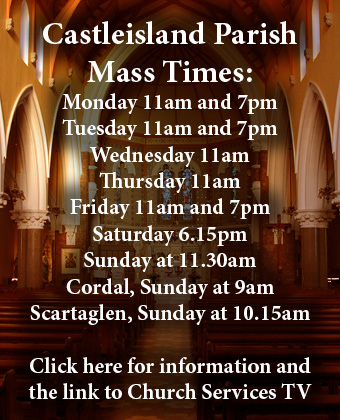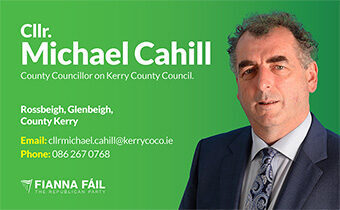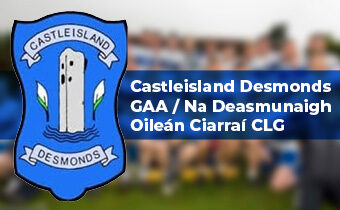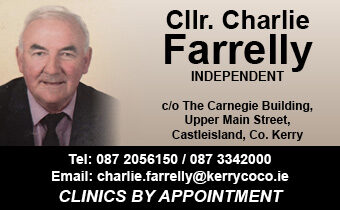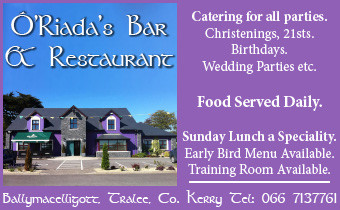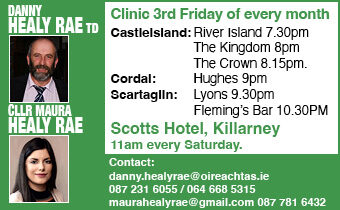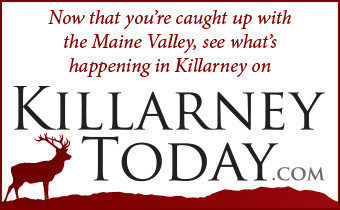

The store of history contained in lines on head-stones within the walls of local cemeteries continues to astound those who take time to appreciate it.
A recent email from Tom O’Connor – a native of Dromulton and now living in Dublin – casts a light on the life of a most remarkable Currow man who was born in 1595 and died in 1662.
Tom O’Connor also draws our attention to the writings of the wonderful Prof. Sr. Margaret MacCurtain on the life and times of Friar Daniel O’Daly.
A headstone in the shadow of the gable of the fallen church at Kilsarcon Cemetery serves as a reminder that the parish produced a man of the calibre of Daniel O’Daly.
Though buried in Lisbon the memorial stone stands in the cemetery in the parish and area of his birth.
Fr. Pat Sugrue

©Photograph: John Reidy
“I came across an interesting book just recently, detailing the life of Kilsarcon native, Friar Daniel O’Daly (1595-1662), who is largely forgotten nowadays, apart from the memorial gravestone erected to him some years back in Kilsarcon Cemetery by Father Pat Sugrue when he was PP in Killeentiarna,” said Tom O’Connor as an introduction.
Historical Papers
“The book is titled Ambassador Extraordinaire – Daniel O’Daly, 1595-1662 by Prof. Margaret Mac Curtain of UCD and Boston College, who is not only a renowned historian but also a Dominican nun – which facilitated her piecing together of the life of Friar O’Daly from the order’s historical papers.
From the evidence disclosed in this book, Friar O’Daly emerges as a historically important world figure, deserving of a place in the pantheon of all-time Kerry Greats.
The Consummate Diplomat
He would appear to have been a bit in the mold of Niccolo Machiavelli, who lived a hundred years earlier – as the consummate diplomat, seamlessly schmoozing between the royal courts in Madrid, Lisbon, Paris, London and the Vatican in Rome.

Here is a synopsis of his life, as told in Margaret MacCurtain’s book – some of which might be of interest to your Maine Valley Post readers.”
Born in Kilsarcan
Daniel O’Daly was born in Kilsarcon in 1595, two years after the Elizabethan soldiers unroofed the neighbouring Catholic Church (in 1593) – whose ruins can still be seen in the present-day cemetery.
His father was Conchubar O’Daly and his mother was an O’Keeffe from the neighbouring barony of Duhallow, where her people were sub-chieftains of MacCarthy Mor.
His father, Conchubhar, son of Maoilseachlainn Og O’Daly, was a notable soldier in the service of the Earl of Desmond – and fought with the Earl to the bitter end in Glanageenty, in 1583.
Rhymer of Kilsarcon
Conchubhar was even more renowned as the Rhymer of Kilsarcon – being the bard to the Earl of Desmond – ie. poet, lawyer, historian & external diplomat for the Geraldines.
Before the fall of the Geraldines, Conchubhar was a powerful landed person, feudal overlord to a broad strip of land, stretching from Nohoval-Daly in east Kerry, through Ballydaly into Duhallow, together with the lands of Cumacheo at the head of the Glenflesk valley. He was essentially overlord to all Sliabh Luachra and a bit beyond).
Fall of the Geraldines
Conchubhar’s ancestors had come south from Ballyvaughan, Co. Clare, where they had been the bards to the O’Loughlin Clan. Conchubhar’s brother, Cuchonnacht O’Daly, was also a poet.
Cuchonnacht, after the fall of the Geraldines, went north to Red Hugh O’Donnell, who famously escaped from Dublin Castle in 1592.
Friar Daniel’s father, Conchubhar, also went North after the fall of the Geraldines; being associated with the Maguire Clan in Fermanagh between the years 1584-9. He returned to Kilsarcon in 1592 and established a school there.
The Battle of Kinsale
Red Hugh O’Donnell rested for a few weeks with the O’Daly brothers in Kilsarcon in 1601, on his march to the Battle of Kinsale, passing over Sliabh Luachra into Duhallow on his way to the battle.
After Kinsale, Cuchonnacht also returns to Kilsarcon in 1601 and joins his brother in maintaining the school, dying in 1642
Daniel (Dominic) was obviously educated in his father’s & uncle’s school in Kilsarcon & then shipped abroad in 1610 to a Dominican House in Lugo in North West Spain to train as a priest, being ordained in 1618.
Back in Kerry
Friar O’Daly was ordained in Burgos in Northern Spain in 1618 & did further studies in Bordeaux.
In 1623, he was back in Ireland, attached to the Emly diocese – leading a fugitive life in the hills and valleys of West Tipperary and East Limerick – probably running hedge schools and recruiting students for the Dominicans.
At some time between 1620-1624, he was back in Kerry & recruited the Moriarty brothers & Thomas Quirke as Dominicans.
In 1624, Friar O’Daly was appointed to the Chair of Theology in the Dominican house in Louvain.
College in Lisbon
In 1628, he went to Madrid and secured the permission of King Philip IV for the foundation of a college in Lisbon.
In June 1629, he arrives in Lisbon & sets about establishing a house for Irish Dominicans; he builds a chapel in 1633 and secures the status-upgrade of their house to that of a College & becomes the Vicar.
In 1633, several cousins of the friar, members of Cuchonnacht O’Daly’s family, by this stage have taken up residence in Spain at San Sebastian near Biscay.
Fight with Spain
In 1636, Friar O’Daly was back in Munster recruiting men to fight with Spain against the British.
In early 1640, Friar O’Daly is imprisoned in England, accused of treason. Somehow he is released – possibly by the intervention of the Spanish ambassador, Don Alonso de Cardenas.
In later 1640, there was a coup d’etat in Portugal & a new King was installed. Friar O’Daly was appointed confessor to the new queen, Luisa de Gusmao & she becomes a major patron/donor to the Friar’s Dominican projects. There is some speculation that Friar O’Daly may have been secretly involved with France’s Foreign Minister, Cardinal Richelieu, in conspiring in the 1640 palace revolution in Portugal.
Philip IV, King of Spain
One of the most significant of his Dominican projects was the establishment of the convent of Bom Sucesso in 1639, which was made possible by attaining a royal license from Philip IV, King of Spain – on agreement that O’Daly would raise troops in Ireland to fight for Spain in the war then in progress with the Netherlands.
In 1644, he turns up in Rome at the world congress of the Dominicans & secures the recognition of his college, Campo Santo, as a studium generale & the placement of his convent under the care of the Irish Dominican province.
The Greatest Honour
There, he is also promoted to Master in Sacred Theology – the greatest honour the Dominican order can bestow. Campo Santo goes on to be the dominant novitiate house for Irish Dominicans in the 18th century – and, when it was sold in later years, it financed the purchase of the Tallaght estate which became the Dominican novitiate in 1856.
Between 1650-1663, it is estimated that more than 40 alumni of O’Daly’s Campo Santo had returned to ministry in Ireland – many of them being hunted down & murdered by the British. His college, Campo Santo became known as the seminary of martyrs.
Charles I of England
From 1650, Friar O’Daly was operating for King Joao IV of Portugal as ambassador to Charles I of England, to the exiled Charles II Stuart and to Popes Innocent X and Alexander VIII in Rome.
In 1655, his diplomatic role was expanded to also include being the Portuguese ambassador to France, where he proved central to negotiating a major international treaty between France & Portugal – and, because of his convoluting dealings here, at times left rivals with suspicions that he had as much allegiance to the French as to the Portuguese.
Audience with King Louis XIV
In 1656, Friar O’Daly had an audience with King Louis XIV (Le Roi Soleil), where he sought to match-make, unsuccessfully, a wedding between the young French King and Catherine of Braganca, daughter of the Portuguese King, Joao IV.
In 1661, the same Catherine of Braganca invited Friar O’Daly to come to England with her as the royal chaplain – which he did not take up – on her marriage to King Charles II of England.
In history, this same Catherine of Braganca is credited with introducing tea-drinking to the English.
Bishop of Coimbra
Having turned down many Church positions over the years, including the Archbishopric of Braga and the Primacy of Goa, in January 1662, Friar O’Daly relented and accepted the nomination to become Bishop of Coimbra but died before taking up the position.
He ensured, however, that his O’Daly relatives were well provided for – securing for them 3000 cruzados and one quarter of the revenue of the see of Coimbra. His brother, Denis’ family were accepted into the ranks of the hereditary nobility and in 1683, his grand-nephew, Don Charles O’Daly was still in receipt of a pension for services originally rendered by Friar Daniel (Dominic).
Supporters and Detractors
Naturally, he had both his supporters and detractors, depending on whose side he was on in the negotiation game. The French Ambassador to Lisbon found him wily and duplicitous, saying:
“Pere Dominique is the most presumptious, the most inconstant, and the craftiest of all men that ever existed. Presumption appears in all his designs; inconstancy in all his actions, and malice is apparent in his whole behaviour. Take good care not to trust too much in his words. He never says what he thinks, and never thinks what he says.”
Tomb Inscription
However, the inscription on his tomb was singularly wholesome in his praise:
In varus Regum legationibus felix – Vir Prudentia, Litteris et Religione conspicuous.
Translated, it says: Successful in embassies for kings – A Man distinguished for prudence, knowledge and virtue.
Recommended Reading
Tom O’Connor also recommends that we read the review of the MacCurtain book in the Irish Times. We can do that with a click on the link here. https://www.irishtimes.com/culture/books/ambassador-extraordinaire-life-of-daniel-o-daly-1595-1662-review-1.3198107

The Maine Valley Post has, is and always will be a free resource for the people of the locality and its wider diaspora.
When we started in 2013, the intention was to be a weekly, online newsletter. Over time, the site has evolved into a much different beast with multiple updates on a daily basis.
Because of its nature as a digital publication, it brings with it certain expenses: computers and cameras that require updating and maintenance; internet hosting and access; to say nothing of the time and hard work that goes into the site. It all adds up…
Our online community has always been our greatest asset and a vocal supporter of the Maine Valley Post since day one.
Please take a moment to click on the link below to see how you can directly contribute to our continued growth and success. Thank you for taking the time……..John Reidy










